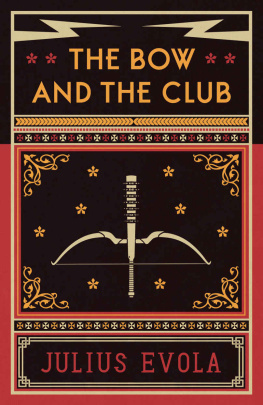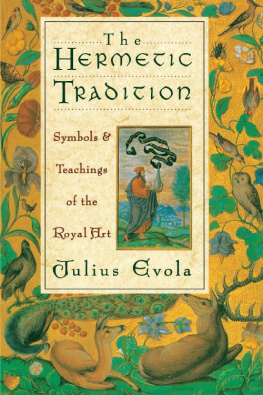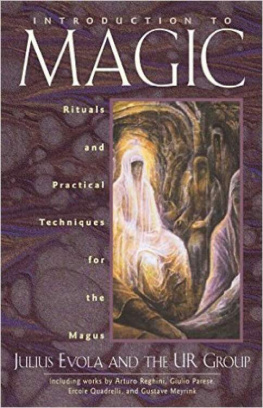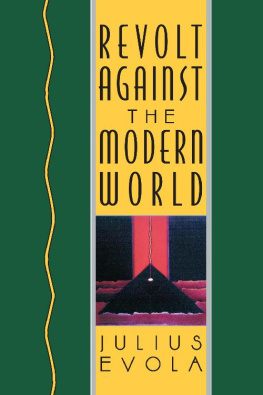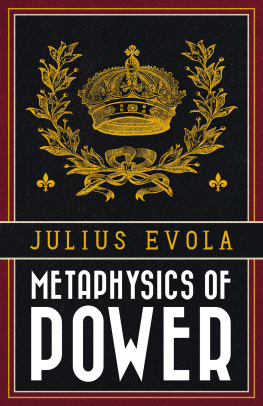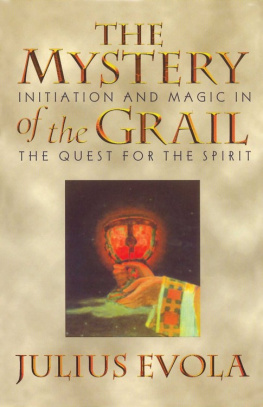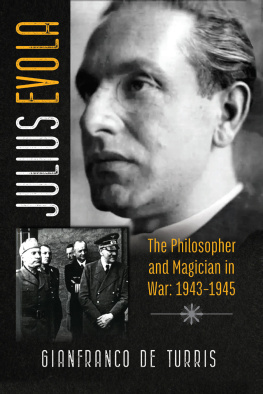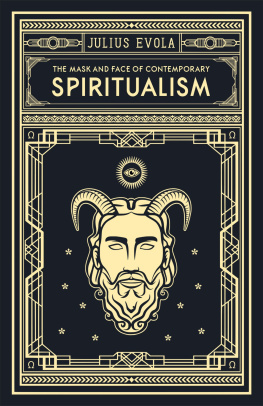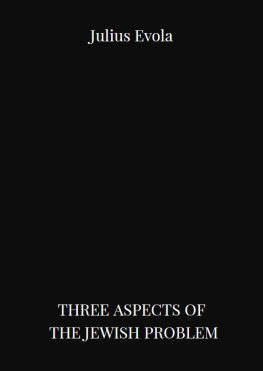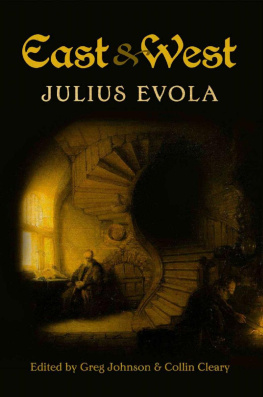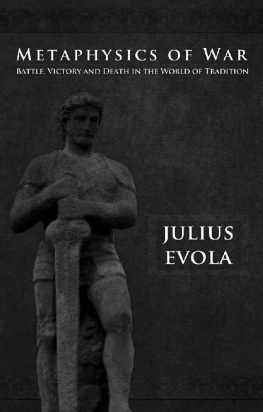Published in 2018 by Arktos Media Ltd.
All rights reserved. No part of this book may be reproduced or utilised in any form or by any means (whether electronic or mechanical), including photocopying, recording or by any information storage and retrieval system, without permission in writing from the publisher.
Originally published as Larco e la clava . Italy, 1968.
Arktos.com | Facebook | Twitter | Instagram
Translation
Sergio Knipe
Editor
John Bruce Leonard
Cover
Andreas Nilsson
Layout
Daniel Friberg
Tor Westman
ISBN
978-1-912079-09-4 (Softcover)
978-1-912079-08-7 (Hardback)
978-1-912079-07-0 (Ebook)
Introduction
1
T he title of the present volume leaves no doubt about the intent of its author: The Bow and the Club is a call to battle.
This impression is strengthened by what Evola himself tells us about its title. In the year 1930, Evola founded and directed a journal called La Torre ( The Tower ) which, as he himself affirms it, sought to gather the few people capable of a revolt against contemporary civilisation ( The Path of Cinnabar , My Experience with La Torre and Its Implications). It included a section called Larco e la clava , The Bow and the Club , which offered a trenchant attack on the press of the time. Evola would resurrect this most evocative phrase some decades hence to head the present collection of essays. He explained the intent of this title most succinctly: the bow, to strike at what is far; the club, to beat down what is near.
The martial element of this book, surely, could not be clearer; it is indeed one of the ubiquitous veins of the present compendium. Virgils arma virumque cano might have been scribed beneath its title; Evola is here at his finest as a cultural warrior in the greatest sense of the term, and a significant portion of his work is dedicated to instilling that same lofty spirit in his readers, particularly in the youngest and most promising of them. The reader will find that in the brief course of these brief essays Evola has laid his hand upon the sickened nerves of modernity, and has closed his fist hard. This book offers a thoroughgoing critique of the atmosphere contemporary with Evolas writingand given that nothing has improved since his time, and everything worsened, his words are even more vital now than when he indited them, half a century ago. Even when he speaks of authors whose names have been all been forgotten in the mere decades standing between this books publication in 1968 and our own day, the ideas and problems they represent remain wholly relevant, and need for the attitude he embodies is tenfold as urgent.
The Bow and the Club enjoyed a success in Italy which was wholly unusual for an Evolian title. The reason is not hard to divine. As Sergio Knipes excellent translation renders in faithful and elegant English, this book is one of the most beautiful of the Evolian oeuvre, and also one of the most accessible. Together with the last book Evola was ever to publish, Recognitions , this book forms a gate of entry into the world that is Evolas philosophy; these two works are uniquely suited as introductions to what one might call, in good Evolian language, the Evolian orientation. The other works of Evola which might lend themselves to such a task are riddled with special problems: Revolt Against the Modern World is in many ways too daunting and, indeed, dis orienting for anyone unaccustomed to Evolas approach to history and to the world in general; The Path of Cinnabar , while being in certain respects excellently suited to the task of introduction, is in many places very personal, and one who comes to Evola without knowing anything about him might occasionally wonder why he should be bothered to care. Moreover, many of the books written by Evola are problematic from the start, insofar as they dedicate themselves to material which lies in ancient history, or even pre history. Modernity is intoxicated with itself, and often does not know how to take even two steps backward in time; it fumbles so soon as it touches the best things of even two or three centuries ago, not to speak of two or three millenniaand certainly not to speak of anything remoter than that.
But both The Bow and the Club and Recognitions stand firm and determined in the contemporary fray itself, taking up arms against the figures and ideals of the present moment. In the right spirit of conservative revolution, they challenge the present with unwavering reference to the past. They confront modernity head on and unapologetically, and for the clarity of their protest and the unflinching and unequivocal quality of their revolt they are as refreshing as a sup of water in a year of drought. Evola even resuscitates at a blow the propriety of reaction: As if, when certain parties act, others should refrain from reacting and instead turn the other cheek like good Christians and say Well done, keep it up! There is something bracing in all of this, something which stirs the slumbering martial spirit in us. More, there is something didactic in it, something which teaches the warriors spirit.
In a certain sense, indeed, this book can be taken as the gift of a worthy and wise elder to the best and most promising youth: Evola would show how the bow and the club are to be wielded. It is no accident that the concern for youth runs as a constant preoccupation throughout both this book (see, for instance, Chapters 6, 11, and 16) and through the chapters of Recognitions . In both these books, Evola the educator steps forth. A generation of Italians responded willingly to his offer; we may pray that this is an augur of things to come. It is most welcome, then, that so fine a translation should at last reach an English public, upon the brink of our hour of need.
2
A word on the order and problems of the present book. The Bow and the Club together with Recognitions are two of the last books that Evola published in his lifetime: between their publication stand but a collection of poetry and a work on Taoism. The Bow and the Club and Recognitions are also unique in the properly Evolian oeuvre for their character as anthologies of essays on a variety of topics; while most of the works penned by Evola rigorously pursue singular and well-defined themes, and do so with a simultaneous breadth, intricacy, and depth of vision, these two works appear at first glance dispersive and arbitrarily arranged. It is easy to suppose that they represent the decline of Evolas last years, a failing of his once intense and concentrated intellectual visionthe product of an aging man who could no longer gather the enormous energy necessary for such powerful, sweeping studies as Revolt Against the Modern World and Men Among the Ruins . The Bow and the Club and Recognitions have been all too often neglected for this, as though their lack of singular theme were to be considered a defectas though the same trait could not as easily be considered, in a certain light, their strength .
In the first place, as can be seen from even a superficial reading of, for instance, Chapters 1, 2, and 19, the essays in the present volume are truly remarkable for their diamond-dense reproduction of a lifetime of study and contemplation. Precisely the contrary of dispersion and waning energy, each essay represents a culmination of centralising powers, an inner light focused upon a point so keenly as to burn . One struggles to think of any other instances in all our literature of statements at once so clear, so brief, so articulate, and so complete, of such fundamental and fundamentally complex questions as the relation between modernity and tradition (Chapters 1 and 19), the rich tensions between North Europe and South Europe (Chapter 13), the essential difference between the Occident and the Orient (Chapter 15), or the problems of initiation (Chapters 11 and 17). The stylistic control and stern, mastered power of vision required to produce such hard and luminous jewels demonstrates beyond any doubt that these works are to be seen, not as the afterword to Evolas productive life, but in a certain sense as its most lapidary and condensed synthesis.
Next page
